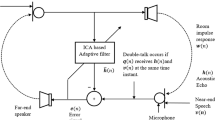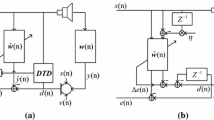Abstract
Acoustic echo cancellation (AEC) plays a prominent role in the present-day hands-free communication environment, owing to the usage of adaptive digital filter techniques. In a duplex communication scenario, there is a need for a double talk detection algorithm in the near-end speaker system which disables the update of the adaptive filter coefficients, thus hindering the process of echo cancellation and leading to a partial solution. To completely solve this problem, independent component analysis (ICA) is used to separate the far-end echo from the mixture of the near-end speech and the far-end echo signal. This paper proposes a new adaptive digital filter using maximum likelihood estimation of ICA and minimization of mutual information of ICA techniques for AEC. The advancement to this technique is made by transforming the observation into an adequate representation using wavelet decomposition. The performance of the echo cancellation is measured in terms of the echo return loss enhancement (ERLE). Higher ERLE indicates better echo cancellation. From the simulation results, it is found that the minimization of the mutual information of ICA has a higher value of ERLE than that by maximum likelihood estimation. The efficiency of the system thus increases by minimizing the processing time using wavelet ICA-based adaptive filter over the conventional adaptive filter.







Similar content being viewed by others
References
A.J. Bell, T.J. Sejnowski, An information-maximization approach to blind separation and blind deconvolution. Neural Comput. 7(6), 1004–1034 (1995)
J. Benesty, D.R. Morgan, J.H. Cho, A new class of doubletalk detectors based on cross-correlation. IEEE Trans. Speech Audio Process. 8(3), 168–172 (2000)
H. Buchner, J. Benesty, T. Gansler, W. Kellermann, Robust extended multi delay filter and double-talk detector for acoustic echo cancellation. IEEE Trans. Audio Speech Lang. Process. 14(5), 1633–1644 (2006)
C.S. Burrus et al., Introduction to Wavelet and Wavelet Transforms, 1st edn. (Prentice Hall Inc., Upper Saddle River, 1998)
J.F. Cardos, Infomax and maximum likelihood for source separation. IEEE Signal Process. Lett. 4(4), 112–114 (1997)
J.F. Cardoso, Blind signal separation: statistical principles. Neural Comput. Surv. 85, 2009–2025 (1998)
J.F. Cardoso, Source separation using higher order moments. Proc. IEEE Int. Conf. Acoust. Speech Signal Process. 4, 2109–2112 (1984)
J.H. Cho, D.R. Morgan, J. Benesty, An objective technique for evaluating double talk detectors in acoustic echo canceller. IEEE Trans. Speech Audio Process. 7(11), 718–724 (1999)
P. Common, Independent component analysis a new concept? Signal Process. 36, 287–314 (1994)
P. Common, C. Jutten, Handbook of Blind Source Separation (Academics, New York, 2010)
D.L. Duttweiler, A twelve-channel digital echo canceller. IEEE Trans. Commun. 26, 647–653 (1978)
T. Gansler, A double-talk detector based on coherence. IEEE Trans. Commun. 44(11), 1421–1427 (1996)
T. Gansler, J. Benesty, A frequency-domain double-talk detector based on a normalized cross-correlation vector. Signal Process. 81, 1783–1787 (2001)
L. Hongyan, R. Guanglong, Blind separation of noisy mixed speech signals based independent component analysis, in Pervasive Computing Signal Processing and Applications (PCSPA). 2010 First International Conference on Pervasive Computing, Signal Processing and Applications (2010), pp. 586–589
A. Hyvärinen, Fast and robust fixed-point algorithm for independent component analysis. IEEE Trans. Neural Netw. 10(3), 624–634 (1999)
A. Hyvärinen, J. Karhunen, E. Oja, Independent Component Analysis (Wiley, New York, 2001)
G. Jake, Learning echo paths during continuous double-talk using semi-blind source separation. IEEE Trans. Audio Speech Lang. Process. 20(2), 646–660 (2012)
J.C. Jenq, S.F. Hsieh, A double talk resistant echo cancellation based on the iterative maximal-length correlation. Proc. Int. Symp. Circuits Syst. 5, 237–240 (2000)
K.H. Lee, J.H. Chang, N.S. Kim, S. Kang, Y. Kim, Frequency domain double-talk detection based on the Gaussian mixture model. IEEE Signal Process. 17(5), 453–456 (2010)
M. Luo, L. Li, G. Qian, H. Liao, Multidimensional blind separation using higher-order statistics: application non-cooperative STBC systems. Circuits Syst. Signal Process. 33(7), 2173–2192 (2014)
U. Mahbub, S.A. Fattah, A single-channel acoustic echo cancellation scheme using gradient-based adaptive filtering. Circuits Syst. Signal Process. 33(5), 1541–1572 (2014)
T. Mei, F. Yin, J. Wang, Blind source separation based on cumulants with time and frequency non-properties. IEEE Trans. Audio Speech Lang. Process. 17(8), 1099–1108 (2009)
G.R. Naik, D.K. Kumar, Improving the quality of the audio sources using Gaussianity reduction technique. Int. J. Electron. 98(7), 949–959 (2011)
G.R. Naik, D.K. Kumar, An overview of independent component analysis and its applications. Inform. Int. J. Comput. Inform. 35(1), 63–81 (2011)
G.R. Naik, W. Wang, Audio analysis of statistically instantaneous signals with mixed Gaussian probability distributions. Int. J. Electron. 99(10), 1333–1350 (2012)
G.R. Naik, Measure of quality of source separation for sub-Gaussian and super-Gaussian audio mixtures. Inform. Int. J. Comput. Inform. 23(4), 581–599 (2012)
F. Nesta, T.S. Wada, B.-H. Juang, Batch-online semi-blind source separation applied to multi-channel acoustic echo cancellation. IEEE Trans. Audio Speech Lang. Process. 19(3), 583–599 (2011)
Y.-J. Park, H.M. Park, DTD-free nonlinear acoustic echo cancellation based on independent component analysis. Electron. Lett. 46(12), 1585–1586 (2010)
D.T. Pham, P. Garat, C. Jutten, Separation of a mixture of independent sources through a maximum likelihood approach, in Proceedings of the EUSIPCO (1992), pp. 771–774
D.W.E. Schobben, P.W. Somment, A frequency domain blind signal separation method based on decorrelation. IEEE Trans. Audio Signal Process. 50(8), 1855–1864 (2002)
M.M. Sondhi, An adaptive echo canceller. Bell Syst. Tech. J. 46(3), 497–510 (1967)
I.Y. Soon, S.N. Koh, C.K. Yeo, Wavelet for speech denoising, in Proceedings of the IEEE TENCON (1997), pp. 479–482
R. Takeda et al., Efficient blind dereverberation and echo cancellation based on independent component analysis for actual acoustic signals. Neural Comput. 24(1), 234–272 (2012)
J.Y. Tourneret, N.B. Bershad, C. Bermudez, Echo cancellation—the generalized likelihood ratio test for double-talk versus channel change. IEEE Trans. Signal Process. 57(3), 916–926 (2009)
T.S. Wada, B.H. Juang, Enhancement of residual echo for robust acoustic echo cancellation. IEEE Trans. Audio Speech Lang. Process. 20(1), 175–180 (2012)
T.S. Wada, B.H. Juang, Towards robust acoustic echo cancellation during double-talk and near-end background noise via enhancement of residual echo, in Proceedings of the IEEE ICASSP (2008), pp. 253–256
B. Widrow, M.E. Hoff, Adaptive switching circuits. IRE Wescon Conv. Rec. 4, 96–104 (1960)
H. Ye, B.-X. Wu, A new double talk detection algorithm based on the orthogonality theorem. IEEE Trans. Commun. 39(11), 1542–1545 (1991)
Acknowledgments
The authors would like to thank the Editor-in-chief, Prof. M.N.S. Swamy, for his help in improving the presentation of the paper.
Author information
Authors and Affiliations
Corresponding author
Rights and permissions
About this article
Cite this article
Mohanaprasad, K., Arulmozhivarman, P. Wavelet-Based ICA Using Maximum Likelihood Estimation and Information-Theoretic Measure for Acoustic Echo Cancellation During Double Talk Situation. Circuits Syst Signal Process 34, 3915–3931 (2015). https://doi.org/10.1007/s00034-015-0038-0
Received:
Revised:
Accepted:
Published:
Issue Date:
DOI: https://doi.org/10.1007/s00034-015-0038-0




